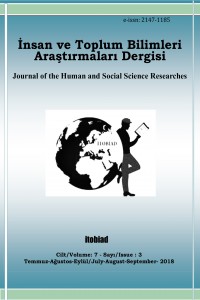Öz
This
article reevaluates the Iranian Revolution as a modern movement. Modern
revolutionary movements spark with an ideological discourse reinforcing
class-consciousness; flourish upon growing sentiments of nationalism, and
mobilize masses with a trigger that deepens the estrangement between state and
society. In terms of its initial motivations, the Iranian Revolution was a
modern political movement. In the Iranian case, ideological discourse targeted
political elites favoring certain segments of the society, and planted the
first seeds of hostility towards Shah’s regime and its foreign supporters.
Modernization reforms and nationalization policies of the 1920-1955 period gave
birth to common nationalist sentiments among influential and discontented
social groups strengthening their reaction against the regime. Finally, the
regime’s decision to allocate growing oil revenues after the 1973 oil crisis to
heavy industry investments and military modernization programs instead of
social development projects deepened the estrangement between state and society
mobilizing masses towards a revolutionary movement.
Anahtar Kelimeler
Iranian Revolution ideological discourse nationalism boom-bust cycles oil revenues allocation and rentier state
Kaynakça
- AMUZEGAR, J. (1999) Managing oil wealth: OPEC’s windfalls and pitfalls. London: IB. Tauris.
- ARJOMAND, S. A. (1988). The turban for the crown: the Islamic revolution in Iran. New York: Oxford University Press.
- DAVIES, J. C. (1962). Toward a theory of revolution. American Sociological Review, 27, 1, 5-19.
- HUNTINGTON, S. (1966a). The political modernization of traditional monarchies. Daedalus, 59, 3 , 763-788.
- HUNTINGTON, S. (1968b). Political order in changing societies. New Haven: Yale University Press.
- KARL, T. L. (1997). The paradox of plenty: oil booms and petro-states. Berkeley: University of California Press.
- KEDDIE, N. R. (1981a). Roots of revolution: an interpretive history of modern Iran. New Haven: Yale University Press.
- KEDDIE, N. R. (1983b). Iranian revolutions in comparative perspective. The American Historical Review, 88, 3, 579-598.
- KRAPELS, E. N. (1980). Oil and security: problems and prospects of importing countries. G. Treverton, Energy and security in. New Jersey: Gower Publishing Company Ltd.
- LUCIANI, G. (1990). The Arab state. Berkeley: University of California Press.
- MAULL, H. (1980). Oil and influence: the oil weapon examined. G. Treverton, Energy and Security in. New Jersey: Gower Publishing Company Ltd.
- MILANI, M. (1994). The making of Iran’s Islamic revolution: from monarchy to Islamic Republic. Boulder: Westview Press.
- MILLER, J. (1996). God has ninety-nine names: reporting from a militant middle east, New York: Simon&Schuster.
- MOADDEL, M. (1993). Class, politics, and ideology in the Iranian revolution. New York: Columbia University Press.
- YERGIN, D. (1992). The prize: the epic quest for oil, money & power. New York: Touchstone Books.
Öz
Bu
makale, İran Devrimi’nin 40. yıldönümüne yaklaştığımız şu günlerde, 20.
Yüzyılın bu son kapsamlı dönüştürücü modern hareketini yeniden değerlendirmeyi
amaçlamaktadır. Modern devrimci hareketler, sınıf bilincini pekiştiren bir
ideolojik söylemle kıvılcımlanır; yükselen milliyetçilik duygusu üzerinden
serpilir ve toplum ile devlet arasında yabancılaşmayı derinleştiren bir
tetikleyici unsur üzerinden kitleleri harekete geçirir. Başlangıç
motivasyonları itibariyle İran Devrimi de, modern bir siyasi harekettir. İran
Devrimi’nde ideolojik söylem, belli toplumsal grupları kayıran yönetimi hedef
almış, Şah rejimi ve yabancı destekçilerine karşı ilk husumet tohumlarını
ekmiştir. 1920’lerin sonu ile 1950’lerin başı arasındaki dönemdeki modernleşme
reformları ve millileştirme politikaları, toplumda etkili hoşnutsuz gruplar
arasında ortak milliyetçi hislerin oluşmasını sağlamış, bu hisler, dış gücün
desteğine dayalı yönetime karşı tepkisel duruşu güçlendirmiştir. Eski rejimin,
1973 Petrol Krizi sonrası artan petrol gelirlerini toplumsal gelişim projeleri
yerine ağırlıklı olarak hızlandırılmış ağır sanayi yatırımları ve ordunun
modernizasyonuna tahsis etmesiyse toplumla yönetim arasında yıkıcı bir
yabancılaşma oluşmasına neden olmuş ve kitleleri harekete geçirmiştir.
Anahtar Kelimeler
İran Devrimi ideolojik söylem milliyetçilik petrol gelirleri ve dağılımı tahsisat ve rantiye devleti boom-bust döngüleri
Kaynakça
- AMUZEGAR, J. (1999) Managing oil wealth: OPEC’s windfalls and pitfalls. London: IB. Tauris.
- ARJOMAND, S. A. (1988). The turban for the crown: the Islamic revolution in Iran. New York: Oxford University Press.
- DAVIES, J. C. (1962). Toward a theory of revolution. American Sociological Review, 27, 1, 5-19.
- HUNTINGTON, S. (1966a). The political modernization of traditional monarchies. Daedalus, 59, 3 , 763-788.
- HUNTINGTON, S. (1968b). Political order in changing societies. New Haven: Yale University Press.
- KARL, T. L. (1997). The paradox of plenty: oil booms and petro-states. Berkeley: University of California Press.
- KEDDIE, N. R. (1981a). Roots of revolution: an interpretive history of modern Iran. New Haven: Yale University Press.
- KEDDIE, N. R. (1983b). Iranian revolutions in comparative perspective. The American Historical Review, 88, 3, 579-598.
- KRAPELS, E. N. (1980). Oil and security: problems and prospects of importing countries. G. Treverton, Energy and security in. New Jersey: Gower Publishing Company Ltd.
- LUCIANI, G. (1990). The Arab state. Berkeley: University of California Press.
- MAULL, H. (1980). Oil and influence: the oil weapon examined. G. Treverton, Energy and Security in. New Jersey: Gower Publishing Company Ltd.
- MILANI, M. (1994). The making of Iran’s Islamic revolution: from monarchy to Islamic Republic. Boulder: Westview Press.
- MILLER, J. (1996). God has ninety-nine names: reporting from a militant middle east, New York: Simon&Schuster.
- MOADDEL, M. (1993). Class, politics, and ideology in the Iranian revolution. New York: Columbia University Press.
- YERGIN, D. (1992). The prize: the epic quest for oil, money & power. New York: Touchstone Books.
Ayrıntılar
| Birincil Dil | İngilizce |
|---|---|
| Bölüm | Makaleler |
| Yazarlar | |
| Yayımlanma Tarihi | 30 Eylül 2018 |
| Yayımlandığı Sayı | Yıl 2018 Cilt: 7 Sayı: 3 |























